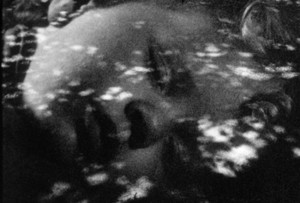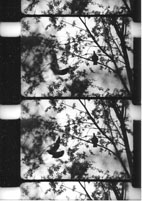Peter Hutton Tribute Screening – Wednesday, August 10
“…For thirty years now, Peter Hutton has been building a radical and singular body of work. A sort of primitive documentary, silent, which celebrates the beauty of the world without forgetting to observe people, the conditions they live and work under…” – Cahiers du cinéma
The loss of Peter Hutton in June robbed personal independent filmmaking of one of its great artists and teachers. Through nearly fifty years of 16mm filmmaking, Peter took one of the fundamental aspects of cinema, the fixed rectangular frame, and made it his primary artistic focus, a means of exploring vision and consciousness. Peter’s elegant compositions were silent windows that documented widely divergent locations as places of mysterious activity, filled with sensual forms and subtle rhythms. The 16mm camera was Peter’s sketchpad, and it accompanied him on his travels to many parts of the world. His sharp observational eye was critical and politically aware, and was always alert to marvels of the moment, visual details that the camera was able to record and that would normally be missed.
My first encounter with Peter and his films was at his first New York show, for the Collective for Living Cinema in 1976. The experience was overwhelming: the films were stunning in their beauty and depth of seeing, and Peter’s responses to questions were deeply thoughtful and clear. In my memory of the evening, he was ruggedly handsome, with a head of unruly, flaming red hair. It was hard to imagine that he had only recently been in school (at the San Francisco Art Institute), since the work seemed to come to him as natural and fully developed as breathing and not the product of any filmmaking program. Buy his rare combination of intellectual rigor and sensual improvisation always flourished in an academic setting.
Peter and I became friends in 1978-79, while he had a one-year residency at Harvard and I was programming and teaching in Boston. One morning, I remember him telling me that he had seen an amazing downtown fire the night before, and that he’d been able to quickly grab his camera in an attempt to document it. We looked at the roll the next week and I was stunned at how perfectly all of the elements – smoke, people, fire, water, darkness – came together as though purposely choreographed into a cinematic dance. Peter’s genius at framing was never more apparent; a horrific accidental event had become an engrossing expression of the complexities and ambiguities of life.
Please join Canyon and me in paying tribute to Peter’s memory with a program of five exquisite short films spanning three decades of his work. While much of Peter’s work was filmed in far-away locations such as Thailand, Iceland, China, Bangladesh, Poland, and Ethiopia, his primary base was Northeastern United States. He especially loved New York City and the Hudson Valley, places he lived following his years in San Francisco during the late sixties and early seventies. Each film is a small gem, and will be shown on luminous black and white 16mm prints.
Everyone will be welcome to add their thoughts about Peter and his work.
— Steve Anker
Join us for a brief reception before Steve introduces the films, as always, the screening will be followed by conversation.
The Canyon Cinema Salon Series is a FREE event hosted at New Nothing Cinema (located at 16 Sherman St, off Folsom between 6th and 7th in SOMA). The Canyon Cinema Salon series is made possible with generous support from the George Lucas Family Foundation and The Owsley Brown III Philanthropic Foundation.
7:00pm- Reception
7:30pm* – Screening and discussion.
*Note: Street entrance locked at 7:30 – please arrive on time.
Films
Florence (1975, 7 min.)
“Like Hutton’s previous films, FLORENCE is a contemplative study of light and shadows, textures and planes, that makes beautiful use of the tonal qualities of black and white film. Throughout the film there is a motion of obscuring and revealing in clouds, reflections and mists, and in the behavior of light as it passes through various openings or substances. Frequently, the images are ambiguous details. One feels that Hutton is very at home in the world he sees, and that he looks at things a little more closely than most people ….” – Ken DeRoux, San Francisco Museum of Modern Art
Landscape (for Manon) (1987, 18 min.)
“First section of an extended study of the weather and landscape in the Hudson River Valley.” (P.H.)
New York Near Sleep (for Saskia) (1972, 10 min.)
“Using exciting juxtapositions of shade and movement, this silent and surreally poetic film examines subtle changes of light and landscape in New York. NEW YORK NEAR SLEEP exploits the basic potential of film for capturing light refractions. Hutton imposes on this film the aesthetics of still photography and uses as a structural device the duration of perception of the subtle reflection of movements and illuminations.” – Bill Moritz, Theatre Vanguard
Study of A River (1997, 16 min.)
“The first part of a seasonal portrait of the Hudson River. This section portrays observations of winter over a period of two years.” (P.H.)
New York Portrait, Chapter III (1990, 15 min.)
“[Hutton’s] latest urban film, NEW YORK PORTRAIT III, takes on a unique tone in relation to Hutton’s ongoing exploration of rural landscape. The very fact that Hutton is dealing with older footage, with archives of memory more than immediacy, gives it a different texture than his earlier New York films, in spite of many continuities with them. Hutton always found the presence of nature in the city, not only in his many shots of sky and vegetation, but also in the geometry and texture of the city itself, which seemed to project an independence from the human. This film seems to bathe itself in a nostalgia for things human, as if Hutton were looking at a vanishing race. Again humor rather than lamentation prevails, but never has it seemed that people were so contingent in Hutton’s films. The high angle of observation, frequent in Hutton’s previous New York films (and an invocation of their diaristic observer quality), here seems to carry a sense of withdrawal, a distance matched by compassion. … The final image in which a small shape against the scale of skyscraper and sky suddenly reveals itself as human by its motion seems emblematic, as does Hutton’s observations of the accidents and rescue of people below on the street.” – Tom Gunning
Peter Hutton, Filmmaker With Austerely Romantic Worldview, Dies at 71 [selections]
by J. HOBERMAN, The New York Times, JUNE 27, 2016
Peter Hutton, an experimental filmmaker noted for his contemplative, sensuous, masterfully photographed portraits of landscapes and cities, died on Saturday in Poughkeepsie, N.Y. He was 71.
Mr. Hutton, who made his first films in the early 1970s, spent over four decades bringing motion pictures back to the moment when the Lumière brothers invented the medium in the 1890s.
All of his films were silent. Generally devoid of camera movement and montage, they suggest sketchbooks or photographic albums. Many are reveries in which the only animation in a precisely balanced composition might come from a wayward breeze or a slight shift in illumination. Most of his films were voluptuously monochromatic. (Mr. Hutton himself was mildly colorblind.)
In a 1978 interview with Sightlines magazine, Mr. Hutton described his films as “diaristic without being autobiographical.” Beginning with “July ’71 in San Francisco, Living at Beach Street, Working at Canyon Cinema, Swimming in the Valley of the Moon” (1971), shot when he was a student at the San Francisco Art Institute, his films were largely defined by place. Locations included Southeast Asia, Eastern Europe, the Soviet Union, China and Iceland, as well as several American cities. The most elusive and melancholy of city symphonies, his three-part “New York Portrait,” was shot mainly in the late ’70s and early ’80s but not completed until 1990.
“Budapest Portrait (Memories of a City)” (1984-86) epitomizes Mr. Hutton’s austerely romantic worldview. The movie is a half-hour succession of moldering apartment houses and massive factories, a place of faded splendor and industrial funk, populated by lonely Stalinist monuments and revolutionary ghosts. Human presence is minimal and typically suggested at one remove by photographs, shadows or bullet holes. The city might be a stage set for an invisible drama.
Peter Barrington Hutton was born in Detroit on Aug. 24, 1944, the son of Donald Hutton and the former Dorothy Plunkett. His father worked in advertising but had earlier served in the merchant marine — an occupation that had a profound effect on the younger Mr. Hutton.
In an interview with the website Cinemad, Mr. Hutton spoke of his childhood fascination with his father’s photo albums. He later took his father’s advice and shipped out with the merchant marine.
“I paid my way through art school by working on ships,” he said. “I went to sea for a semester, then to school for a semester, back and forth from sea to school.”
Mr. Hutton had originally wanted to be a painter and studied art in Hawaii. He began making films at the San Francisco Art Institute, where he received bachelor’s and master’s degrees in fine arts.
Such was Mr. Hutton’s eye that the often gritty urban landscapes of his city films can seem as natural as a peat bog or a rain forest. In the mid-1980s, he settled in the Hudson River Valley and took that landscape — the inspiration for one of America’s first major schools of indigenous painters — as his own in films like “Landscape (for Manon)” (1986-87), a depiction of Kaaterskill Clove; “In Titan’s Goblet” (1991), a movie taking its title from a painting by Thomas Cole; and “Study of a River” (1994-96), a contemplation of ships on the Hudson. In 2010, the National Film Registry of the Library of Congress selected “Study of a River” for permanent preservation.
Mr. Hutton saw himself in modest terms. “I’ve never felt that my films are very important in terms of the history of cinema,” he said in an interview with the film scholar Scott MacDonald. “They offer a little detour from such grand concepts. They appeal primarily to people who enjoy looking at nature, or who enjoy having a moment to study something that’s not fraught with information.
“The experience of my films is a little like daydreaming.”



